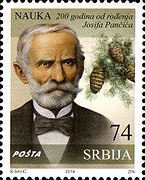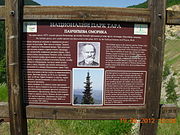Josif Pančić
Josif Pančić | |
|---|---|
| Јосиф Панчић | |
 Josif Pančić | |
| Born | April 17, 1814 |
| Died | February 25, 1888 (aged 73) |
| Citizenship | Serbian |
| Alma mater | University of Budapest |
| Known for | discovery of Serbian Spruce |
| Scientific career | |
| Author abbrev. (botany) | Pančić |
Josif Pančić (Serbian Cyrillic: Јосиф Панчић; April 17, 1814 – February 25, 1888) was a Serbian botanist, a doctor of medicine, a lecturer at the Great School (the future University of Belgrade), and the first president of the Serbian Royal Academy.[1] He extensively documented the flora of Serbia, and is credited with having classified many species of plants which were unknown to the botanical community at that time.[2] Pančić is credited with discovering the Serbian spruce. He is regarded as the father of Serbian botany.[3]
Life
[edit]Early life and studies
[edit]Josip Pančić was born in Ugrini, near Crikvenica, on the Military Frontier, a territory in the Habsburg monarchy. At the time of his birth, the region was part of the French Empire. Pančić was the fourth son of Pavel Pančić and his wife Margarita. His paternal grandfather, who came from the area around Niš, had served in a volunteer battalion of the Austrian Imperial Army during the Austro-Turkish War.[4][5] According to tradition, the Pančić family hailed from Herzegovina and settled in Ugrini in olden times.[6]
After finishing elementary school in Gospić, he went on to the lyceum in Rijeka, and then continued classes in the Regia Academica Scientiarum in Zagreb (1830). He graduated in 1842 in Budapest in medicine. In addition to other courses, Pančić attended botany courses, taught by the then renowned botany professor, Joseph Sadler (Sadler József).[7] Later, recalling those early lectures, he wrote:[3]
And since the first course in botany I started to love botany and decided to become a botanist, so I started to botanize excitedly and to collect plants around Pest and Buda,...
Work
[edit]While studying about botany at the Natural History Museum in Vienna, Pančić became acquainted with the Serbian linguist Vuk Stefanović Karadžić who wrote him a letter of recommendation to the Serbian authorities, in order to fulfill his wish to settle in the Principality of Serbia to study Nature.[8] In May 1846, he arrived in Serbia where for the first seven years he worked as a physician in rural area. In 1847, he asked to be released from his Austrian citizenship and applied for Serbian citizenship, the same year he met his future wife Lyudmila Mileva.[9]
In 1853, he moved from Kragujevac to Belgrade when he was first appointed adjunct professor at Belgrade Lyceum's Department of Natural History and Agronomy by decree of Prince Alexander Karadjordjević, before becoming a full-time professor of Natural History and Agriculture in 1854, as decreed by the Ministry of Education of the Principality of Serbia.[10]
As Professor of Natural Sciences, he as one of the six original professors (along with Konstantin Branković, Jovan Sterija Popović, Đura Daničić, Matija Ban, and Dimitrije Nešić), of the Lyceum of the Principality of Serbia.[11]
He later became rector of the Great School (the future University of Belgrade) and the founder of the Institutes of Mineralogy and Geology, Zoologial and Botanical Departments and of the experimental botanical gardens in Belgrade.[10]
Pančić extensively documented the flora of Serbia and is credited with having classified many species of plants that were unknown to the botanical community at the time. He discovered a total of 47 valid species new to science.[12] The crowning achievement of Pančić floristic studies was the "Flora of the Principality of Serbia" (Flora Kneževine Srbije) published in 1874, while a supplement was added ten years later. His explorations marked the golden age of Serbia's botany.[12]
His most significant discovery was the Serbian Spruce,[13] which he discovered near Zaovine on the Tara Mountain in 1875. He firmly established Serbian botany among European sciences. He ascertained that Serbia's flora was rich and worthy of further studies.[12] During the Serbian–Ottoman War (1876–1878), he was the Chief Physician of the Belgrade Hospital.
He is said to have "fallen in love" with Kopaonik, which he visited 16 times between 1851 and 1886.[14] Pančić was named the first president of the Serbian Royal Academy formed on April 5, 1887. He requested the opening of the Botanical garden "Jevremovac" in Belgrade.[15] Pančić died on 25 February 1888, his last wish was to be buried in the Kopaonik Mountain.[16]
Legacy
[edit]
A mausoleum of Josif Pančić was erected at the highest peak of Kopaonik in 1951 by the Academy of Science, the University of Belgrade and the Hiking club,[17] with the inscription:
Honoring Pančić's request, we moved him here to rest forever. Here is his message to the Serbian youth: "Only with a thorough understanding and analysis of the nature of our country will they show how much they love and honor their homeland".
A research society has been named after him, Josif Pančić Biological Research Society (Biološko istraživačko društvo "Josif Pančić"). He was depicted on the 10 Dinars note printed in 1994. He is included in The 100 most prominent Serbs. In 1951, the highest point in the Kopaonik mountain range was changed from Milan Peak to Pančić's Peak.[18]
On April 17, 2010, Google celebrated his birthday with a Google Doodle.[19]
Awards
[edit]Selected works
[edit]- Die Flora der Serpentinberge in Mittel-Serbien (1859)
- Pisces Serbiae (1860)
- Zur Moosflora des nordöstlichen Banates (1861)
- Arena mobilis in Serbia eiusque flora (1863)
- Flora agri Belgradensis methodo analytica digesta – "Flora u okolini Beogradskoj po analitičnom metodu" (1865)
- Šumsko drveće i šiblje u Srbiji (1871)
- Flora Principatus Serbiae – "Flora knez̆evine Srbije ili vaskularne biljke, koje y Srbije divlie rastu" (1874)
- Eine neue conifere in den östlichen Alpen (1876)
- Flora u okolini Beogradskoj po analitičnoj sistemi (1878)
- Elementa ad floram principatus, Bulgariae (1883)
- Nova graca za flora knez︠h︡evine Bugarske (1886)
- Collected works in 11 volumes[21]
Gallery
[edit]-
Pančić on a Serbian stamp, 2014
-
The mausoleum of Josif Pančić on Pančić's Peak
-
Information board about Pančić and his spruce tree at the site where it was discovered on the Tara mountain
-
The Serbian Spruce discovered by Pančić
Notes
[edit]- His name is mostly written as Serbian Josif Pančić (Јосиф Панчић).
See also
[edit]References
[edit]- ^ Petrović, Goran (2020-09-01). At the Lucky Hand: aka The Sixty-Nine Drawers. Deep Vellum Publishing. ISBN 978-1-64605-015-4.
- ^ Lubarda, Biljana (2014). "Plant species and subspecies discovered by Dr. Josif Pančić 1 – distribution and floristic importance". Botanica Serbica. 38 (2).
- ^ a b Vasić, Olja. "Josif Pančić and the new Fora of Serbia" (PDF). Flora Mediterranea. 23: 209–214. ISSN 2240-4538. Archived from the original (PDF) on 4 August 2016. Retrieved 20 October 2015.
- ^ "Pobedio". NOVOSTI (in Serbian). 2020-07-25.
- ^ Krumin, Spas (2015). Miljenici profesora Pančića. Niš: University library "Nikola Tesla". pp. 12, 19. ISBN 978-86-7500-004-4.
- ^ Josif Pančić, Budislav Tatič, Božidar P. M. Ćurčić (1998). Sabrana dela Josifa Pančića: Život i delo Josifa Pančića. Zavod za udžbenike i nastavna sredstva. p. 13.
Проф. др Љубиша М. Глишић ЖИВОТ И РАД ВЕЛИКОГ НАУЧНИКА И РОДОЉУБА др ЈОСИФА ПАНЧИЋА Према предању, Панчићи су пореклом из Херцеговине и од давнина су се доселили у село Угрине, које се налази на ...
{{cite book}}: CS1 maint: multiple names: authors list (link) - ^ Stevanović et al. 1999.
- ^ "Josif Pančić". srednjeskole.edukacija.rs. Retrieved 2019-12-12.
- ^ "Живот и прикљученија Јосифа Панчића - Politikin Zabavnik". politikin-zabavnik.rs (in Serbian). 2014-10-09. Archived from the original on 2014-10-09.
- ^ a b Pavlović, P.; Kostić, N.; Karadžić, B.; Mitrović, M. (2017). The Soils of Serbia. World Soils Book Series. Springer Netherlands. ISBN 978-94-017-8660-7.
- ^ Miomir Komatina (31 March 2004). Medical Geology: Effects of Geological Environments on Human Health. Elsevier. pp. 359–. ISBN 978-0-08-053609-5.
- ^ a b c Ioannes Tsekos; Michael Moustakas (6 December 2012). Progress in Botanical Research: Proceedings of the 1st Balkan Botanical Congress. Springer Science. p. 142. ISBN 978-94-011-5274-7.
- ^ Ballian, Dalibor (2018). "NEW FINDINGS OF SERBIAN SPRUCE (Picea omorika (Panč.) Purk.) IN BOSNIA AND HERCEGOVINA".
- ^ "Josif Pancic i Kopaonik". staro.skijanje.rs. Retrieved 2019-12-12.
- ^ "KAKO JE PODIGNUT JEVREMOVAC – Nauka kroz priče". 22 February 2018. Retrieved 2019-12-12.
- ^ "Serb National Council :: Josif Pančić". Srpsko Narodno Vijeće. Archived from the original on 2019-03-23. Retrieved 2020-12-23.
- ^ "Mauzolej Josifa Pančića propada". www.novosti.rs (in Serbian (Latin script)). Retrieved 2019-12-12.
- ^ "Josif Pancic i Kopaonik". 2011-01-03. Archived from the original on 2011-01-03. Retrieved 2019-12-28.
- ^ "Josif Pancic's Birthday". Google. 17 April 2010.
- ^ a b c "Istraživač Srbije". P-portal (in Croatian). 2024-04-14. Retrieved 2024-10-30.
- ^ "SABRANA DELA JOSIFA PANČIĆA". www.knjizara.zavod.co.rs. Retrieved 2019-12-12.
- ^ International Plant Names Index. Pančić.
Sources
[edit]- Nikola Diklić. "Josif Pančić" (PDF). Lives and Work of the Serbian Scientists. 1: 3–61. Archived from the original (PDF) on 2015-06-21. Retrieved 2016-01-08.
External links
[edit]- "Josif Pančić" Јосиф Панчић (in Serbian). Serbian Academy of Sciences and Arts. Archived from the original on 2011-10-09. Retrieved 2009-03-11.
- Vladimir Stevanovic; Radomir Konjevic; Slobodan Jovanovic; Dmitar Lakušic; Snežana Vukojičic; Marjan Niketic (1999). "Life road of Josif Pancic". Retrieved 2007-07-12.
- 1814 births
- 1888 deaths
- Serbian people of Croatian descent
- 19th-century Serbian people
- Serbian botanists
- Members of the Serbian Academy of Sciences and Arts
- Academic staff of Belgrade Higher School
- People from Primorje-Gorski Kotar County
- People from the Principality of Serbia
- People from the Kingdom of Serbia
- Immigrants to the Principality of Serbia
- Serbian paleontologists
- Serbian Roman Catholics
- Habsburg Serbs
- Serbian Austro-Hungarians
- Academic staff of the Lyceum of the Principality of Serbia






